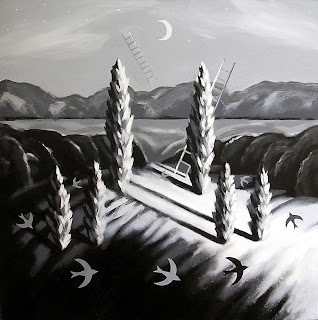Lance Kinseth, Calling
Down Moon, 48x48”
DRUM SINGS SKY DOWN.
Drum’s vibrations obviously pulse through us, but they are
far more than drum’s. In that way
in which a wave is the ocean, these vibrations are Sky-sized.
Endless Sky, containing Earth and galaxies and Cosmos, comes
down.
Sky is already here, inside mass, inside us and the
surrounding space, and unbound in the holy river and sea. The trees and mountains are Sky.
Drum forms a pathway for the essentials of Sky to come down
or for you and I to go up.
Raven and Crow are two of the essentials—faces of Sky. Raven and Crow are present, even
already inside us, and yet—like Sky—are touchless.
Perhaps one time Moon or Raven comes down and perhaps in
another time we go up to Crow, and still more magic: we do not move.
If we are lucky we sense them and we interact with them.
If we are even more lucky, a time will come when they are
known to be us.
The atmosphere is the essence of their bodies and of your
body as well.
And yet, we spend most of our time in a world that does not
exist, that we contrive, and call this very real reality of Sky a “dream.”
Sky is our very existence in each moment and, in its vast,
unending formless form, that which designs us and expresses us. Our most real scientific measures are
saying this to us.
Our hands are Sky’s hands.
Sky is the body of spirit that extends out beyond galaxies
and cosmos.
We exist deep inside spirit as a congealed form of energy to
fit the local conditions of existence.
We are not little pieces of spirit.
There is no end or beginning to us, no separation, no
previous life, no coming and going, no ending and beginning.
The differences that we feel—such as what I choose to eat or
how you dress—are real, but small and narrow expressions of our identity and of
our limits.
A fish is river-shaped; a blossom is the tilt of the Earth
toward the sun.
And were we to get hold of it, opening a pathway into Sky
can optimize us, attune us to the longer reaches of ourselves, bring us into
harmony, and heal and sustain us.
**********
DRUM PULSE IS SKY SONG.
WHEN SKY SWEEPS DOWN in drum sound, all is transformed. Be it far northern Eskimo kilaut or Koryak boubin. Drum’s vibration sweeps
sky into the present moment.
Do you seek it’s wisdom?
Sky is more than space above landscape. Sky is the farther reach of
landscape. Earth is in it, as well
as star—Sun—and Milky Way Galaxy that contains Sun as a small obscure star, and
all galaxies and the farthest reach of cosmos, that unknown terrain of universe
or universes and/or more.
And Sky is the immanent form of Raven and Crow that can seem
ghost-like to us, appearing to wear the appearance of thin air. Spirit-Beings are not really
spirit-beings in the catholic sense, not real this thing or that thing, not
really something either exclusively outside or inside, but rather, are
manifestations of inseparable, interpenetrating Sky.
When Sky sweeps down, as Sky endlessly does, but typically
so far outside our consciousness, Raven/Crow/Moon sweeps down. In drum sounds, Sky sings and comes
down or we fly out to meet Raven/Crow.
When we leave the world that we have contrived, we find ourselves
inseparable an in a world where self and landscape are no more or no less than
facets of a whole. We look at our
experience contriving parts and miss the elephant. It is like trying to cut the river into parts to see the
river. Sky is the horizontal and
vertical terrain in front of our senses as well as the literal atmosphere above
us that presses into us as our very breath and our very sensing as well.
And perhaps if we are lucky—if we are “called” into such
consciousness—Raven/Crow/Moon open this inseparability.
Spiritually, we are likely to imagine the landscape as
separable from ourselves, either as a stage-set in which we act out a rather
brief temporal life before entering a more
spiritual, transcendent “heaven” or as a landscape of “come-arounds” in which our soul moves across life spans though a
variety of forms.
Shamanically, however, landscape—that is far more sky than
solid mass as its physical and spiritual essence—is god-like, and we—deep
within it, ensouled rather than a separate soul—are expressions of this
godliness.
Not just for aesthetic pleasure, awareness that everything
that is landscape is in us brings us inside is this very deep reality to
optimize each moment.







